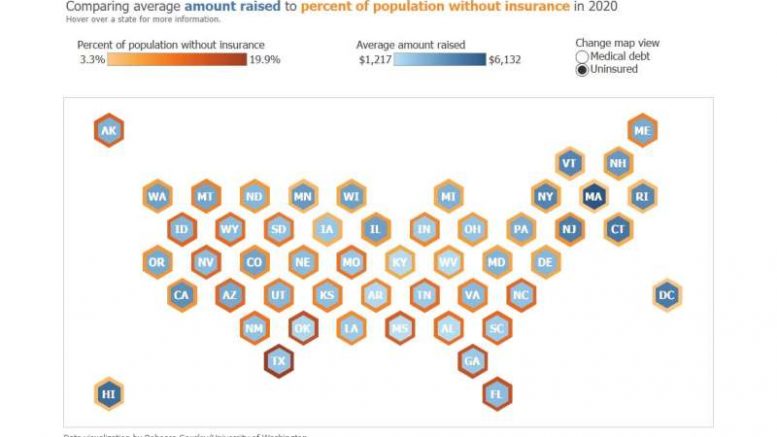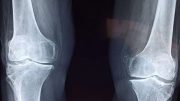Crowdfunding offers little assistance to the uninsured in paying for health care and exacerbates inequality.
Crowdfunding is sometimes promoted as a “safety net” for people who are unable to pay their medical expenditures.
However, according to new research from the University of Washington, which is thought to be one of the first large-scale assessments of medical crowdfunding in the United States, people in states with higher medical debt and lower insurance coverage are more likely to try to raise money but are less likely to succeed.
Researchers point out that this so-called safety net isn’t much of one at all.
“We tend to think of crowdfunding as something that can help anyone in a pinch,” said Nora Kenworthy, associate professor of nursing and health studies at UW Bothell. “However, this data really indicates that where people need the most help paying for health care, crowdfunding provides the least help.”
The study, which was published in the American Journal of Public Health on Feb. 3, investigated crowdfunding use and outcomes at the county and state levels using data from over 437,000 GoFundMe projects over a five-year period.
Kenworthy and UW co-author Mark Igra, a graduate student in sociology, used Census data and other information to determine how many campaigns were formed and how much money was raised in locations with different income levels, medical debt, and health insurance coverage.
The University of Washington researchers looked into many aspects of crowdfunding, such as who uses it, where they live, and how effective their campaigns are.
Last year, Igra and Kenworthy looked at crowdfunding during the first few months of the COVID-19 pandemic and discovered that campaigns in wealthier and more educated communities were more successful, a trend they attributed not only to financial resources but also to potentially wider—and wealthier—social networks.
Igra and Kenworthy also discovered that 90 percent of initiatives failed to accomplish their objectives, regardless of location.
The researchers wanted to look into medical crowdfunding and see if it can aid people who are struggling to pay for health care in the United States.
More than one-third of campaigns on GoFundMe, which controls the majority of the crowdfunding industry in the United States, is dedicated to health care. According to GoFundMe, more than 250,000 medical fundraising campaigns are launched each year, raising more than $650 million.
From 2016 to 2020, the University of Washington study compiled one of the largest publicly available datasets of GoFundMe campaigns, demonstrating that while more campaigns were started in low-income and under-insured communities, campaigns in more affluent communities with higher rates of insurance coverage raised significantly more money. Among the results:
The 437,596 campaigns in GoFundMe’s “medical, disease, and healing” category raised more than $2 billion during that five-year period, with the median campaign garnering just under $2,000.
During that time, 16 percent of campaigns raised no money, and just around a quarter of those did meet their target.
The median number of donations and returns has been declining over time, reaching its lowest point in 2020.
In 2020, just under 18% of campaigns were launched in locations with the highest household income category (between $73,000 and $130,000), yet they raised more than a quarter of all funds raised.
In the same year, 20% of campaigns ($19,000 to $47,000) were launched in the lowest income category, accounting for 12% of total earnings. This is less than half of the high-income bracket’s earnings.
Similarly, states with higher percentages of persons with medical debt and no insurance saw more advertising. Those campaigns raised less money than other states’ campaigns.
Mississippi, for example, has the greatest number of people with medical debt and one of the highest rates of uninsured people in the country, but its crowdfunding efforts raised the least money of any of the 50 states.
Researchers found one number that struck out when looking at data from 2020, the most recent full-year available: 33.8 percent of campaigns were unfunded.
Because the percentage differed so considerably from previous years, when it ranged from zero to four percent, researchers assume the epidemic was not the sole culprit.
Instead, it appears that more successful campaigns spend more time on the website, therefore past years’ data may over-represent successful campaigns. Unfunded initiatives also appear to be withdrawn from the site after a year, either by the campaign authors or by the website moderators, according to the researchers.
“Because the campaigns people see on social media are virtually always the small subset that gets shared widely,” Igra explained, “the public may have the idea that crowdfunding is more likely to be successful than it is.”
According to the researchers, greater transparency from all crowdfunding companies would allow for more research and policymaking to help address the very needs that crowdsourcing professes to address.
While thousands of people use crowdsourcing to pay for medical expenditures, the findings of the study suggest a more equitable and complete solution: increased health insurance coverage and social assistance programs.
“Using market-based solutions only serves to exacerbate already significant health disparities. This study emphasizes the necessity for greater safety net measures that support everyone who needs it “Kenworthy remarked.






pharmacies in mexico that ship to usa – mexico pharmacies prescription drugs mexican pharmaceuticals online
buying prescription drugs in mexico
mexican rx online – mexico pharmacies prescription drugs reputable mexican pharmacies online
mexico drug stores pharmacies
buying from online mexican pharmacy – mexican border pharmacies shipping to usa medicine in mexico pharmacies
medicine in mexico pharmacies
mexican rx online – medication from mexico pharmacy mexican pharmaceuticals online
buying prescription drugs in mexico online
reputable mexican pharmacies online – mexican border pharmacies shipping to usa mexican border pharmacies shipping to usa
best mexican online pharmacies
mexican online pharmacies prescription drugs – mexican pharmaceuticals online mexican pharmaceuticals online
buying prescription drugs in mexico online
pharmacies in mexico that ship to usa – reputable mexican pharmacies online mexican online pharmacies prescription drugs
mexican online pharmacies prescription drugs
buying prescription drugs in mexico online – mexican pharmaceuticals online reputable mexican pharmacies online
mexican mail order pharmacies
medicine in mexico pharmacies – purple pharmacy mexico price list mexico pharmacies prescription drugs
mexico drug stores pharmacies
mexico drug stores pharmacies – best mexican online pharmacies mexican rx online
buying from online mexican pharmacy
cost of ivermectin 1% cream https://ivermectin.today/# where to buy ivermectin pills
stromectol ivermectin tablets https://ivermectin.today/# buy liquid ivermectin
stromectol in canada https://ivermectin.today/# ivermectin iv
ivermectin 4000 mcg https://ivermectin.today/# purchase oral ivermectin
ivermectin buy online https://ivermectin.today/# ivermectin 3mg tablets
stromectol cvs https://ivermectin.today/# ivermectin 3 mg
ivermectin over the counter canada https://ivermectin.today/# ivermectin for humans
ivermectin 3mg tablets https://ivermectin.today/# ivermectin oral
ivermectin 80 mg https://ivermectin.today/# stromectol ireland
oral ivermectin cost https://ivermectin.today/# stromectol 3 mg
ivermectin 5: ivermectin buy stromectol canada
ivermectin 8000: stromectol ivermectin tablets ivermectin drug
ivermectin generic cream: ivermectin price uk buy ivermectin cream
cost of stromectol medication: ivermectin for humans ivermectin 50ml
ivermectin buy: stromectol nz stromectol for humans
purchase amoxicillin 500 mg https://amoxil.icu/ amoxicillin 875 125 mg tab
amoxil generic https://amoxil.icu/ buy amoxicillin online cheap
where can i buy amoxicillin online https://amoxil.icu/ amoxicillin 250 mg capsule
buy amoxicillin 500mg https://amoxil.icu/ amoxicillin 500mg price canada
amoxicillin 500mg for sale uk https://amoxil.icu/ amoxicillin 500 mg capsule
amoxicillin brand name https://amoxil.icu/ where can i buy amoxicillin without prec
amoxicillin buy online canada https://amoxil.icu/ amoxicillin 500mg prescription
paxlovid cost without insurance https://paxlovid.win/ paxlovid pill
paxlovid cost without insurance https://paxlovid.win/ paxlovid
paxlovid price https://paxlovid.win/ paxlovid pharmacy
get clomid now https://clomid.site/ clomid without dr prescription
can you get clomid tablets https://clomid.site/ cost of generic clomid without insurance
get cheap clomid without insurance https://clomid.site/ how can i get clomid for sale
how can i get cheap clomid https://clomid.site/ how to get generic clomid tablets
can you buy generic clomid https://clomid.site/ where to get generic clomid without dr prescription
https://doxycyclinebestprice.pro/
can you buy zithromax over the counter in mexico https://zithromaxbestprice.icu/ can i buy zithromax online
zestoretic cost https://lisinoprilbestprice.store/ lisinopril 20 mg tab price
100 mg lisinopril https://lisinoprilbestprice.store/ lisinopril 20 mg pill
order lisinopril 20mg https://lisinoprilbestprice.store/ no prescription lisinopril
nolvadex generic https://nolvadex.fun/ aromatase inhibitor tamoxifen
generic tamoxifen https://nolvadex.fun/ tamoxifen mechanism of action
where can i buy amoxicillin over the counter uk amoxicillin tablet 500mg 875 mg amoxicillin cost amoxil.guru
amoxicillin 500 mg without prescription amoxicillin generic amoxicillin tablet 500mg amoxil.guru
amoxicillin 825 mg buy amoxicillin online cheap cost of amoxicillin 30 capsules amoxil.guru
amoxicillin 50 mg tablets buy amoxicillin amoxicillin 500mg amoxil.guru
where to buy amoxicillin over the counter amoxicillin script buy amoxicillin online no prescription amoxil.guru
where can i buy amoxicillin without prec amoxicillin price canada amoxicillin tablet 500mg amoxil.guru
buying clomid without rx where buy clomid price can i order cheap clomid clomid.auction
how to buy clomid cost cheap clomid no prescription how can i get generic clomid without dr prescription clomid.auction
prednisone brand name buy prednisone online without a script prednisone prescription drug prednisone.auction
paxlovid india paxlovid covid paxlovid price paxlovid.guru
Paxlovid buy online
paxlovid for sale paxlovid pill paxlovid india paxlovid.guru
paxlovid pill
buy paxlovid online paxlovid pharmacy Paxlovid over the counter paxlovid.guru
paxlovid generic
prednisone without prescription medication https://prednisonepharm.store/ prednisone 20 mg purchase
tamoxifen endometriosis https://nolvadex.pro/ tamoxifen and antidepressants
tamoxifen joint pain https://nolvadex.pro/ buy nolvadex online
liquid tamoxifen https://nolvadex.pro/ how to prevent hair loss while on tamoxifen
nolvadex steroids https://nolvadex.pro/ tamoxifen alternatives premenopausal
nolvadex half life https://nolvadex.pro/ where can i buy nolvadex
tamoxifen and weight loss https://nolvadex.pro/ tamoxifen hip pain
tamoxifen and grapefruit https://nolvadex.pro/ hysterectomy after breast cancer tamoxifen
aromatase inhibitor tamoxifen https://nolvadex.pro/ tamoxifen skin changes
tamoxifen alternatives premenopausal https://nolvadex.pro/ nolvadex pills
tamoxifen https://nolvadex.pro/ tamoxifen medication
cytotec buy online usa https://cytotec.directory/ cytotec buy online usa
cytotec pills online https://cytotec.directory/ cytotec pills online
cytotec pills buy online https://cytotec.directory/ Misoprostol 200 mg buy online
buy misoprostol over the counter https://cytotec.directory/ Misoprostol 200 mg buy online
cytotec abortion pill https://cytotec.directory/ buy cytotec over the counter
buy cytotec https://cytotec.directory/ buy cytotec over the counter
how to get clomid without a prescription https://clomidpharm.shop/ generic clomid
india online pharmacy https://indianpharmacy.shop/# – canadian pharmacy india indianpharmacy.shop
indian pharmacy paypal https://indianpharmacy.shop/# – canadian pharmacy india indianpharmacy.shop
indian pharmacy paypal https://indianpharmacy.shop/# – india pharmacy indianpharmacy.shop
cheapest online pharmacy india https://indianpharmacy.shop/# – legitimate online pharmacies india indianpharmacy.shop
mexican mail order pharmacies https://mexicanpharmacy.win/# mexico drug stores pharmacies mexicanpharmacy.win
purple pharmacy mexico price list https://mexicanpharmacy.win/# pharmacies in mexico that ship to usa mexicanpharmacy.win
mexico drug stores pharmacies https://mexicanpharmacy.win/# best mexican online pharmacies mexicanpharmacy.win
mexican rx online https://mexicanpharmacy.win/# buying prescription drugs in mexico mexicanpharmacy.win
canadian pharmacy no rx needed https://canadianpharmacy.pro/# – canada pharmacy online canadianpharmacy.pro
canadian pharmacy online https://canadianpharmacy.pro/# – canadian pharmacy oxycodone canadianpharmacy.pro
buying prescription drugs in mexico https://mexicanpharmacy.win/# mexican rx online mexicanpharmacy.win
cheap canadian pharmacy online https://canadianpharmacy.pro/# – legit canadian pharmacy online canadianpharmacy.pro
mexican pharmacy online reviews https://canadadrugs.pro/# – canadian pharmacies reviews canadadrugs.pro
no perscription pharmacy https://canadadrugs.pro/# – buying drugs canada canadadrugs.pro
pharmacy express online https://canadadrugs.pro/# – prescription meds without the prescription canadadrugs.pro
canadian wholesale pharmacy https://canadadrugs.pro/# – legitimate online pharmacies india canadadrugs.pro
best non prescription online pharmacies https://canadadrugs.pro/# – best canadian pharmacies canadadrugs.pro
canadian pharmacy prescription https://canadadrugs.pro/# – canadian drug store coupon canadadrugs.pro
non prescription drugs https://canadadrugs.pro/# – canadian drug canadadrugs.pro
best canadian pharmacy to order from https://canadianinternationalpharmacy.pro/ best canadian online pharmacy
legal canadian pharmacy online https://canadianinternationalpharmacy.pro/ pharmacy wholesalers canada
cheap canadian pharmacy online https://canadianinternationalpharmacy.pro/ canadian pharmacy 365
canada pharmacy online legit https://canadianinternationalpharmacy.pro/ canadian pharmacy price checker
trusted canadian pharmacy https://canadianinternationalpharmacy.pro/ pharmacy canadian superstore
mexican drugstore online https://certifiedpharmacymexico.pro/ medicine in mexico pharmacies
mexican pharmaceuticals online https://certifiedpharmacymexico.pro/ buying prescription drugs in mexico
buying prescription drugs in mexico online https://certifiedpharmacymexico.pro/ mexico drug stores pharmacies
medication from mexico pharmacy https://certifiedpharmacymexico.pro/ purple pharmacy mexico price list
mexican rx online https://certifiedpharmacymexico.pro/ best mexican online pharmacies
mexican online pharmacies prescription drugs https://certifiedpharmacymexico.pro/ pharmacies in mexico that ship to usa
ciprofloxacin order online https://cipro.guru/ buy ciprofloxacin over the counter
ciprofloxacin generic price https://cipro.guru/ buy cipro online canada
ciprofloxacin 500 mg tablet price https://cipro.guru/ where can i buy cipro online
cipro pharmacy https://cipro.guru/ ciprofloxacin mail online
https://doxycycline.auction/
sweeti fox https://sweetiefox.online/ – Sweetie Fox izle
Sweetie Fox video https://sweetiefox.online/ – sweeti fox
Angela Beyaz modeli: https://angelawhite.pro/ Angela White filmleri
أنجيلا وايت: https://angelawhite.pro/ Angela White izle
أنجيلا وايت: https://angelawhite.pro/ Angela Beyaz modeli
swetie fox https://sweetiefox.online/ – Sweetie Fox filmleri
Sweetie Fox filmleri https://sweetiefox.online/ – Sweetie Fox izle
Sweetie Fox filmleri https://sweetiefox.online/ – sweeti fox
Sweetie Fox video https://sweetiefox.online/ – sweety fox
lana rhoades unleashed – https://lanarhoades.pro/ lana rhoades videos
aRTW8j sweetie fox new https://sweetiefox.pro/ – ph sweetie fox
mia malkova movie: https://miamalkova.life/ mia malkova latest
mia malkova: https://miamalkova.life/ mia malkova latest
mia malkova videos: https://miamalkova.life/ mia malkova only fans
aviator oyna slot: https://aviatoroyunu.pro aviator hilesi
aviator bahis: https://aviatoroyunu.pro aviator hilesi
pin up aviator https://aviatorjogar.online/ – aviator pin up
jogar aviator online https://aviatorjogar.online/ – aviator jogo
aviator betting game https://aviatormalawi.online – aviator betting game
aviator bet: https://aviatorghana.pro/ aviator login
pin-up cassino https://pinupcassino.pro/ pin up casino
cassino pin up https://pinupcassino.pro/ pin up aviator
melhor jogo de aposta – https://jogodeaposta.fun/ melhor jogo de aposta para ganhar dinheiro
melhor jogo de aposta – https://jogodeaposta.fun/ jogo de aposta
ganhar dinheiro jogando – https://jogodeaposta.fun/ jogos que dão dinheiro
depósito mínimo 1 real – https://jogodeaposta.fun/ ganhar dinheiro jogando
play aviator https://aviatormalawi.online – aviator betting game
aviator mz https://aviatormocambique.site aviator moçambique
You have a gift for explaining things in an understandable way. Thank you!
This post is packed with useful insights. Thanks for sharing your knowledge!
sweet bonanza https://sweetbonanza.bid/ – sweet bonanza yasal site
sweet bonanza siteleri https://sweetbonanza.bid/ – sweet bonanza kazanma saatleri
bonus veren slot siteleri https://slotsiteleri.guru/ slot oyun siteleri
slot siteleri https://slotsiteleri.guru/ slot casino siteleri
pin-up casino: https://pinupgiris.fun/ aviator pin up
aviator giriş https://aviatoroyna.bid – aviator
This article is a perfect blend of informative and entertaining. Well done!
I appreciate the clarity and thoughtfulness you bring to this topic.
mexico pharmacies prescription drugs http://mexicanpharmacy.shop/# mexico drug stores pharmacies mexicanpharmacy.shop
This article was a delightful enjoy reading. Your passion is clearly visible!
trusted canadian pharmacy: my canadian pharmacy rx vipps approved canadian online pharmacy canadianpharmacy24.store
canadian pharmacy victoza: thecanadianpharmacy canadian pharmacy online store canadianpharmacy24.store
Thank you for making complex topics accessible and engaging.
I’m bookmarking this for future reference. Your advice is spot on!
A masterpiece of writing! You’ve covered all bases with elegance.
This post is a testament to your expertise and hard work. Thank you!
Your blog is a go-to resource for me. Thanks for all the hard work!
The dedication to high quality content is evident. Keep up the great work!
Always excited to see The posts, like waiting for a message from a crush. Another excellent read!
This post was a breath of fresh air. Thank you for your unique insights!
casino trực tuyến uy tín https://casinvietnam.shop/# – đánh bài trực tuyến
Your post was a beacon of knowledge. Thank you for illuminating this subject.
You’ve articulated your points with such finesse. Truly a pleasure to enjoy reading.
Your passion for this subject shines through your words. Inspiring!
Thank you for the hard work you put into this post. It’s much appreciated!
Your post has been incredibly helpful. Thank you for the guidance!
buy generic ciprofloxacin https://ciprofloxacin.tech/ ciprofloxacin generic price
buy cipro online https://ciprofloxacin.tech/ cipro
I appreciate the balance and fairness in The writing, like a perfect partner who always keeps things interesting. Great job!
The ability to convey nuanced ideas with clarity is as alluring as a whispered secret.
The arguments were as compelling as The online persona. I’m totally sold—and not just on The ideas.
The blend of informative and entertaining content is perfect. I enjoyed every word.
Thank you for adding value to the conversation with The insights.
The information you’ve shared has been a revelation for me. Incredibly enlightening!
Explaining things in an understandable way is a skill, and you’ve mastered it. Thanks for clearing things up for me.
The passion for this subject shines through The words. Inspiring!
Discovering The Writing has been a game-changer for me. The contributions are invaluable.
The analysis is like a well-crafted movie—engaging, enlightening, and leaving me thinking long after it’s over.
The insights add so much value, like an unexpected compliment that brightens one’s day. Thanks for sharing.
The writing is a masterpiece. You managed to cover every aspect with such finesse.
The perspective is incredibly valuable to me. Thanks for opening my eyes to new ideas.
Incredibly helpful post, like a GPS for my lost thoughts.
You have a gift for explaining things in an understandable way, much like a smooth talker who knows just what to say.
Elegant and insightful, you tackle hard to understand issues like you’re dancing through words. Shall we dance some more?
Amazed by The knowledge breadth, or what I’ve been mistaking for just good Googling skills.
The ability to present nuanced ideas so clearly is something I truly respect.
The words are like a melody, each post a new verse in a song I never want to end.
Appreciate the balance and fairness, like a judge, but without the gavel.
yes
I always learn something new from The posts. Thank you for the education!
The post resonated with me on many levels. Thank you for writing it!
I’m so grateful for the information you’ve shared. It’s been incredibly enlightening!
Bookmarking this! The practical advice is something I’ll definitely be coming back to.
Packed with insights, or what I call, a buffet for the brain.
A masterpiece of writing! You’ve covered all bases with elegance.
The post was a beacon of knowledge. Thank you for illuminating this subject.
Reading The work is like catching up with an old friend; comfortable, enlightening, and always welcome.
This piece was beautifully written and incredibly informative. Thank you for sharing!
https://gpsites.win/story.php?title=shattered-no-more-a-comprehensive-guide-to-auto-glass-replacement#discuss
https://tempaste.com/S6QpqUMSS5r
https://ralph.bakerlab.org/show_user.php?userid=779701
https://tubalook03.bravejournal.net/shattered-no-more-the-ultimate-guide-to-auto-glass-replacement
You’ve got a way with words that’s as enchanting as a full moon. I’m bewitched.
https://atavi.com/share/wodhtiz10dxcn
Good article and straight to the point. I am not sure if this is
really the best place to ask but do you folks have any thoughts on where to get some
professional writers? Thanks 🙂 Escape rooms
https://bookmarkingworld.review/story.php?title=the-glass-half-full-your-guide-to-auto-glass-replacement#discuss
The attention to detail is as attractive as it is thorough. I appreciate a person who notices the little things.